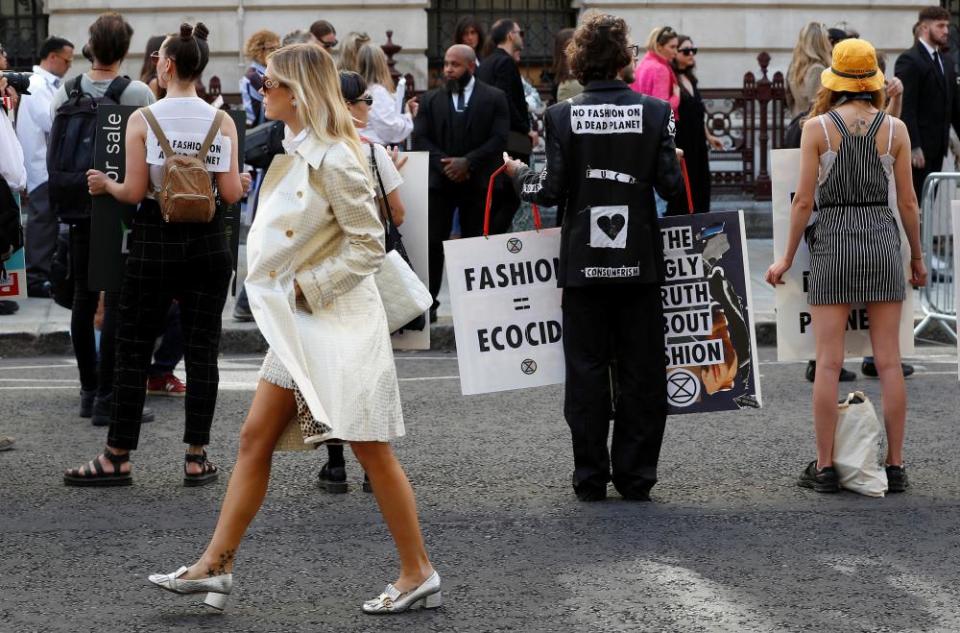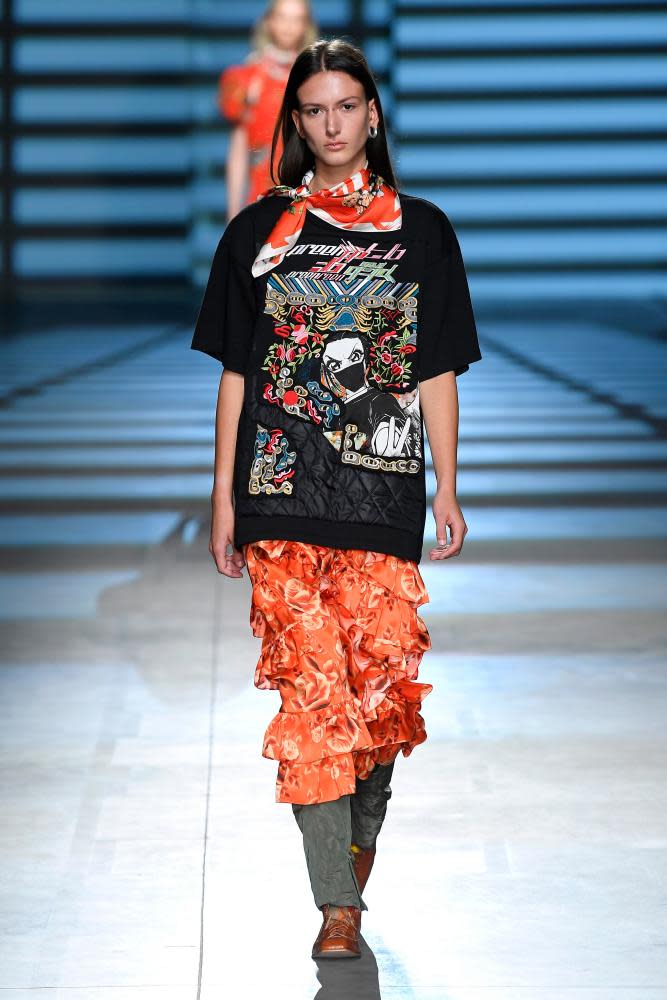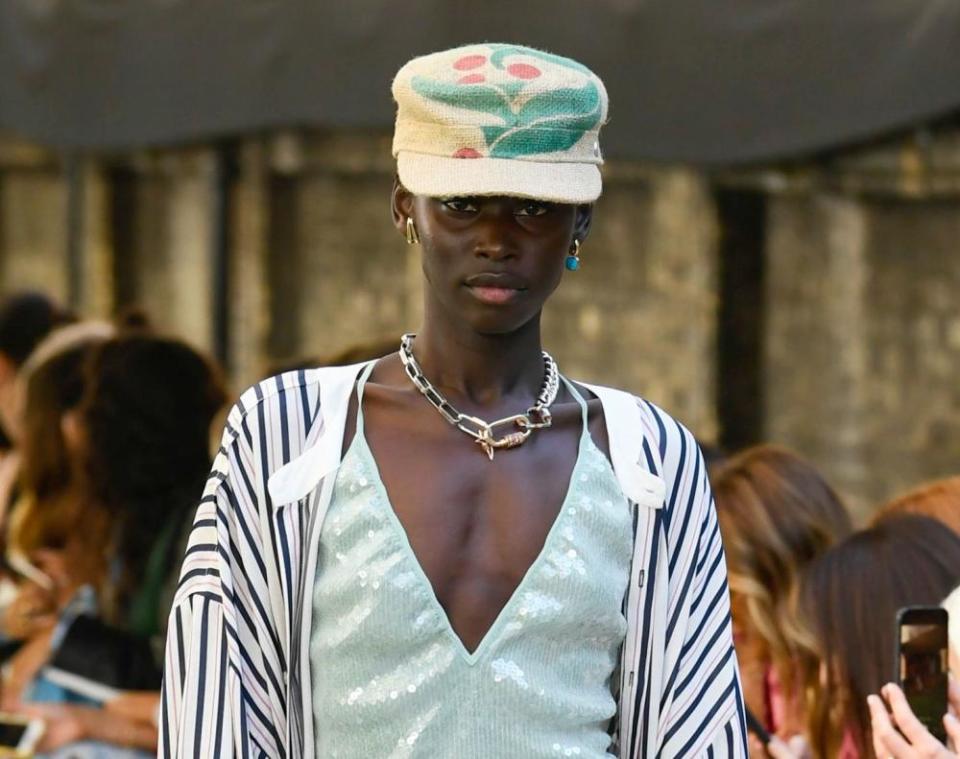So hot it hurts: London fashion week in the age of climate activism

As irony would have it, the Sunday of London fashion week was a freakishly warm day for mid-September. Victoria Beckham’s show was being held in the Foreign and Commonwealth Office, so there was a queue snaking down King Charles Street in Westminster while ID cards were checked, bags were scanned and the audience lolled in the sunshine. On the other side of the road, the fashion queue was mirrored by an orderly lineup of climate crisis activists – many dressed not dissimilarly from the fashion crowd, with a lean toward asymmetric clothing and unusual sunglasses – holding placards reading “The Ugly Truth About Fashion” and “Business As Usual Is Killing The Planet”.
Sara Arnold, an Extinction Rebellion spokesperson, talked eloquently about the need to “wake people up to their power as citizens, not consumers”. A fashion photographer, perhaps misjudging the mood, began to heckle her, only to be shushed by the very showgoers who the protesters were facing off against. “If we realise and act now, we have the power to change our course,” Arnold continued. The fashion industry audience listened politely, until all the Saint Laurent and Gucci handbags had been through the scanner and we could file into the show space, where a view of David Beckham and Dame Helen Mirren displaced from our minds any thought of the imminent demise of the human race.
Welcome to Late Stage Capitalism: The Musical – the show formerly known as fashion week. Fashion week has never just been about fashion. It is a microcosm of everything that is compelling and seductive about modern life, and of everything that is terrifying about modern life as well. The gaudy consumerism that makes fashion week an increasingly queasy spectacle isn’t just about handbags: it’s about the processed food we eat, the packaging we use, the trips we make by car and plane. Fashion week is an all-singing, all-dancing, jazz-hands live-action hot take on how we live.
Fashion has been the golden child of popular culture for two decades. From Sex and the City to Beyoncé’s politically charged wardrobe in the Formation video, from the Oscar red carpet to Chanel’s Superbowl-sized catwalk shows, fashion has broadcast to the whole world. Fashion weeks in Lagos and Copenhagen as well as London, New York, Milan and Paris have fed on the intravenous energy of their cities, becoming a modern version of the royal box at the opera house: the place to see and be seen as both powerful and glamorous. (We have a word for that, in fashion. It’s called being fabulous.)

Fashion’s lure to celebrity extends way beyond the ranks of reality TV stars. Last Thursday, the day London fashion week began, I was at a lunchtime event with Meghan, Duchess of Sussex, and then spent the evening down-table from Theresa May at a women’s-only dinner thrown by the designer Anya Hindmarch. If fashion is the new opium of the masses, fashion week is the A-list’s guilty pleasure.
But the climate crisis has set fashion on a collision course with the zeitgeist. This is both a practical and a philosophical problem for fashion. Practical, first, because of the ever-increasing production of new clothes and the churn of landfill this leaves in its wake. But philosophical, too, because fashion has to be about looking ahead. If fashion doesn’t engage with the future, it literally isn’t fashion.
“The climate crisis is this generation’s war, and wars change everything,” said Hindmarch at dinner on Thursday. There is a new seriousness to the mood music in fashion. Alpha front-row reading now means Fashionopolis: The Price of Fast Fashion and the Future of Clothes by Dana Thomas, or The Testaments. (The most-Instagrammed bag of show week was a tote bag printed with the cover of the new Atwood novel. If you can’t track that down, there’s a Guardian x Katharine Hamnett tote in partnership with Friends of the Earth, on sale Thursday.) If you are reading a magazine, make it the new issue of Teen Vogue with Greta Thunberg on the cover.

It is now more of a status symbol to boast about how old your clothes are, whether sourced from your own wardrobe or from a vintage store, than how new-season they are. Deadstock – unsold clothes from past seasons – is a buzzword all of a sudden. Backstage after the Preen show on Sunday morning, the designer Justin Thornton told me that some pieces in the collection would be made in limited runs, as they were being produced “out of deadstock we had in the studio from old seasons, that we wanted to reuse rather than buying new fabric”. Ganni, the cult Danish label that opened its first London store this week, regularly makes capsule collections out of old-season stock. Roland Mouret, who is on a mission against the wastefulness of single-use clothes hangers – “the plastic straws of the fashion industry” – also featured upcycled baseball caps by the Berlin milliners ReHats.

A pivot away from new clothes doesn’t mean the end of fashion. Curated edits of pre-loved clothes are emerging as a model to bring hanger-appeal and contemporary relevance to secondhand clothes. At its most upscale, this can mean vintage Paris fashion hand-picked by Marie Blanchet at William Vintage. But it can also be rented designer pieces from MyWardrobe.com, from where you can borrow a Gucci handbag or a Burberry trenchcoat, boosting your wardrobe and the circular economy at the same time. Also on the rise is peer-to-peer rental on Hurr Collective, where a week’s rental of a new designer piece is usually around 15% of the retail price.
It has become fashionable to predict that the future of fashion is the end of trends, but I’m not convinced. Watching models in white sunglasses and silk headscarves dance in feathered minidresses and foxy tailoring by the British luxury brand 16Arlington at its show this weekend, where the collection was inspired by the glamour of 1960s Italy, reminded me how evocative and desirable a retro look can be. These clothes were newly made, but a vintage-oriented fashion mindset could take such a show as a jumping-off point to fall back in love with old pieces in a wardrobe, an attic, or a secondhand store. With the future not looking all that pretty, nostalgia could be a rising stock. Fashion isn’t going away any time soon. But to keep pace with the zeitgeist, it needs to smarten up its act.

